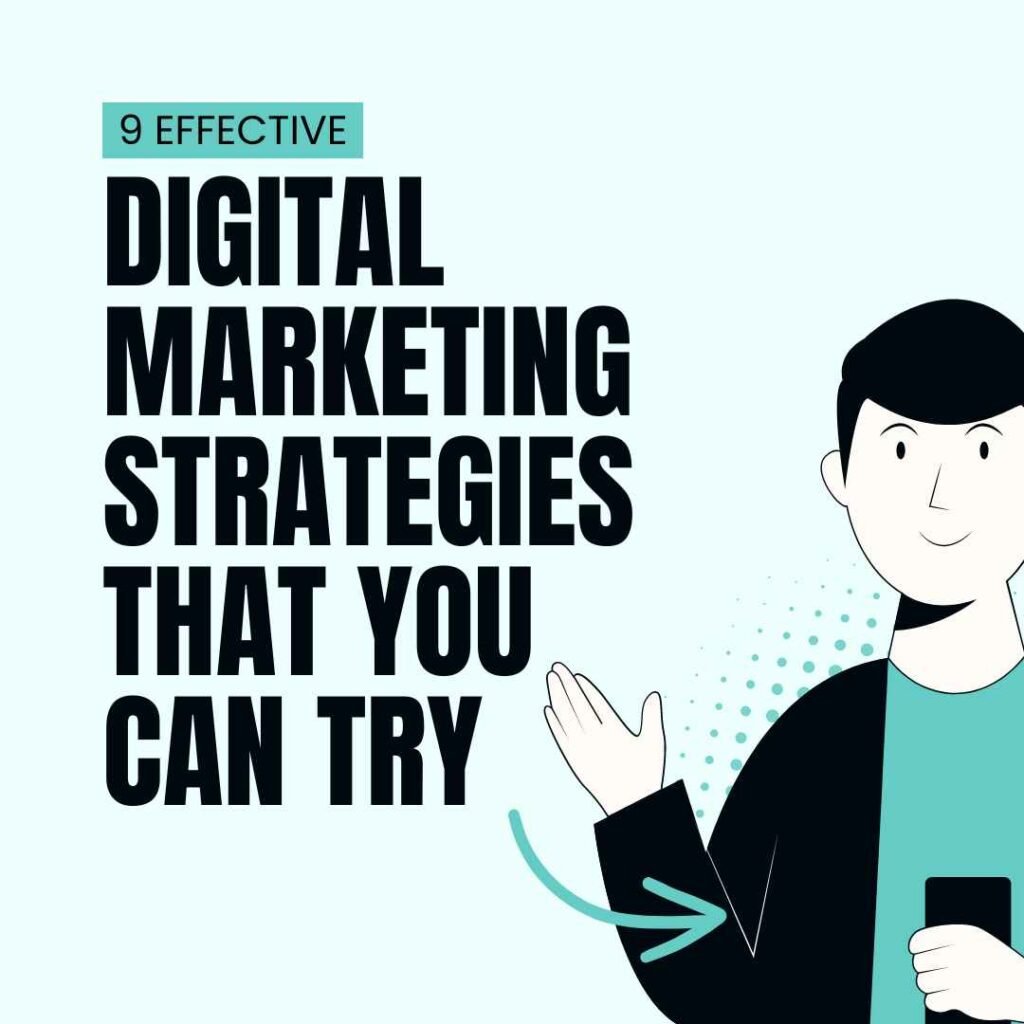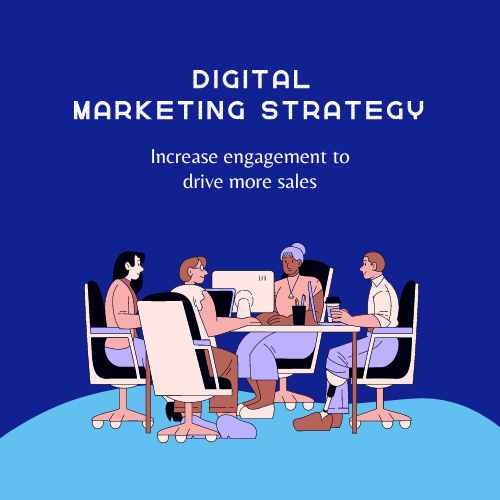Table of contents
How to Develop an Effective Digital Marketing Strategy in 2024
Create a powerful 2024 digital marketing strategy: Set clear goals, know your audience, leverage AI, focus on content, and track results.
Once upon a time, in a bustling little town, there was a small hosiery shop named “Comfort Wear.”
Mr. Sharma, a hardworking and kind-hearted man, owned this shop.
Mr. Sharma had everything you could think of in his store:
Comfortable lowers, stylish uppers, trendy tracksuits for women, beautiful kurti’s for women, t-shirts for men, undergarments for everyone, soft towels, cosy socks, and even children’s undergarments.
However, despite having such a variety of products, Mr. Sharma’s sales were not very high.
He often wondered how he could bring more customers into his shop.
One day, his friend Ravi visited him.
Ravi was a digital marketing expert and had some exciting ideas to help Mr. Sharma.
He introduced Mr. Sharma to the concept of a “digital marketing strategy.”
Understanding the Digital Marketing Strategy
Ravi explained that a digital marketing strategy is a plan to promote your business online.
It’s like setting up a signboard in the digital world, so more people know about your shop and what you sell.
Even though Mr. Sharma’s English wasn’t perfect, Ravi made sure to explain everything in simple terms.

Step 1: Knowing Your Audience
Ravi suggested Mr. Sharma create “customer personas,” which are like imaginary characters representing his customers.
For example, he created a persona named “Mrs. Gupta,” a mother looking for comfortable and stylish clothes for her family.
This helped Mr. Sharma think about what his customers wanted.
Step 2: Setting Clear Goals
Next, Ravi explained the importance of setting clear goals. Goals help us know what we want to achieve.
For instance, Mr. Sharma’s goal could be to get 100 new customers in the next three months or to increase sales by 20%.
Ravi introduced Mr Sharma to the concept of SMART goals, which are:
Specific: Clear and specific goals, like “increase daily walk-in customers.
Measurable: Goals that can be counted, like “get 100 new customers.
Achievable: Goals that are possible to reach.
Relevant: Goals that matter to the business.
Time-bound: Goals with a deadline, like “within three months.
Step 3: Choosing the Right Digital Channels
Ravi then talked about choosing the right digital channels to reach more people.
He explained that social media platforms like Facebook and Instagram are great places to start.
These platforms allow Mr Sharma to showcase his products and connect with customers.
Ravi helped Mr Sharma set up a Facebook page and an Instagram account for Comfort Wear.
They posted pictures of the latest kurtis for women, tracksuits, and undergarments, and even shared some special offers.
Step 4: Creating Engaging Content
Content is what we share online, Ravi said. It can be pictures, videos, or even simple posts about the shop and products.
The key is to make the content interesting and engaging. Mr Sharma and Ravi started posting pictures of new arrivals, like colourful socks and comfortable t-shirts.
They also shared short videos showing how to mix and match outfits or how to choose the right size for children’s undergarments.
Ravi explained that consistent posting is important. So, they made a plan to post something new every day.
Step 5: Using SEO (Search Engine Optimization)
SEO is a digital marketing strategy to make sure people can find your shop online.
Ravi explained it simply: when someone searches for “hosiery shop in my town” on Google, you want Comfort Wear to appear at the top of the search results.
They used keywords like “hosiery shop,” “comfortable tracksuits,” and “quality undergarments” in their posts and on their website.
Ravi also helped Mr Sharma write good titles for his posts, like “Top 5 Comfortable Tracksuits for Women” and “Affordable Kurtis for Daily Wear.”
Step 6: Engaging with Customers on Social Media
Social media is a digital marketing strategy which isn’t just about posting pictures; it’s also about talking to customers.
Ravi showed Mr Sharma how to reply to comments and messages.
When someone asked about the price of a product or the availability of a size, Mr. Sharma replied quickly and politely.
This made customers feel valued and more likely to visit the shop. Ravi explained that engaging with customers builds trust and encourages them to come to the shop.
Step 7: Using Email Marketing
Email marketing is a digital marketing strategy that involves sending emails to customers to keep them informed about new products and special offers.
Ravi helped Mr Sharma collect email addresses from customers who visited the shop.
They sent out simple emails with updates about new arrivals, special discounts, and even some fashion tips.
Ravi explained that personalizing emails, like using the customer’s name, makes them feel special.
Step 8: Measuring and Analysing Results
To see if the digital marketing strategy was working, Ravi showed Mr Sharma how to measure and analyse results.
They used simple tools like Facebook Insights and Instagram Analytics to check how many people saw their posts and how many liked or commented.
They also checked the number of customers visiting the shop.
Ravi explained that if they saw more people coming in and buying products, it meant their strategy was working. If not, they could make changes to improve it.
Step 9: Budgeting for Digital Marketing Strategy
Ravi explained the importance of setting a budget for digital marketing strategy.
Mr. Sharma decided how much money he could spend on ads, content creation, and tools.
They made sure to keep track of expenses to stay within the budget.
Ravi showed Mr Sharma how to run simple ads on Facebook and Instagram to reach more people in the local area.
These ads showed pictures of the latest products and offered discounts to attract customers.
The Result: More Walk-In Customers and Increased Sales
Within a few months, Mr. Sharma started seeing more customers walking into Comfort Wear.
People mentioned they saw the shop’s posts on Facebook or Instagram, or they received an email about a special offer.
Sales increased, and Mr. Sharma was thrilled.
Ravi’s digital marketing strategy helped Mr. Sharma’s shop grow.
By understanding his audience, setting clear goals, choosing the right digital channels, creating engaging content, using SEO, engaging with customers, using email marketing, measuring results, and budgeting, Mr Sharma turned Comfort Wear into a popular local shop.
Conclusion
In conclusion, even a small hosiery shop like Comfort Wear can benefit greatly from a good digital marketing strategy.
By following simple steps and using easy-to-understand tools, Mr. Sharma was able to attract more customers and increase his sales.
If you have a small business, try these strategies and see the difference they can make.
And remember, you don’t have to be an expert in English to succeed; just start with small steps and keep learning along the way. Happy marketing!
Quick Listicles for Your Business Success Using the Digital Marketing Strategy
Running a small hosiery shop can be challenging, but with the right digital marketing strategy, you can bring in more customers and increase your sales.
We’ve covered a lot of ground on how to boost your hosiery shop’s sales with a digital marketing strategy.
Here are some quick listicles summarizing the key points to make it even easier for you.
Follow these steps to see how you can do the same for your shop.
These are bite-sized tips you can refer to anytime!
1. Understand Your Audience
Why It’s Important: Knowing who your customers are helps you tailor your digital marketing strategy efforts.
- Identify Demographics: Think about the age, interests, and location of your customers.
- Create Customer Personas: Imagine fictional characters representing your typical customers. For example, “Mrs. Gupta,” a mother looking for comfortable clothes for her family.
2. Set Clear Goals
Why It’s Important: Goals help you stay focused and measure your success.
- SMART Goals: Make your goals Specific, Measurable, Achievable, Relevant, and Time-bound.
- Example: “Get 100 new customers in three months” or “Increase sales by 20%.”
3. Choose the Right Digital Channels
Why It’s Important: Using the right platforms helps you reach your audience effectively.
- Social Media: Platforms like Facebook and Instagram are great for showcasing products.
- Website or Blog: Having an online presence helps customers find your shop.
- Email Marketing: Keep customers informed about new products and special offers.
4. Create Engaging Content
Why It’s Important: Interesting content keeps your audience engaged and attracts new customers.
- Types of Content: Use pictures, videos, and posts about your products.
- Content Calendar: Plan when to post content to maintain consistency.
- Example: Post pictures of new kurtis, videos on styling tracksuits, or tips on choosing undergarments.
5. Use SEO (Search Engine Optimization)
Why It’s Important: SEO is a digital marketing strategy which helps people find your shop online through search engines like Google.
- Keywords: Use words like “hosiery shop,” “comfortable tracksuits,” and “quality undergarments.”
- Good Titles: Write clear and descriptive titles for your posts.
- Example: “Top 5 Comfortable Tracksuits for Women.”
6. Engage with Customers on Social Media
Why It’s Important: Engaging with customers builds relationships and encourages loyalty.
- Respond to Comments: Answer questions and thank customers for their feedback.
- Direct Messages: Reply to messages promptly and politely.
- Example: If someone asks about product availability, respond quickly with the information
7. Use Email Marketing
Why It’s Important: Email marketing is a digital marketing strategy keeps customers informed and interested.
- Build an Email List: Collect email addresses from customers.
- Send Newsletters: Share updates, special offers, and fashion tips.
- Personalize Emails: Use the recipient’s name to make emails feel special.
8. Measure and Analyze Results
Why It’s Important: Analyzing results helps you understand what’s working and what needs improvement.
- Tools to Use: Facebook Insights, Instagram Analytics, and Google Analytics.
- Key Metrics: Look at the number of visitors, likes, comments, and sales.
- Example: If you see more customers visiting your shop, your strategy is working.
9. Budget for Digital Marketing Strategy
Why It’s Important: A budget helps you manage your expenses and maximize your marketing efforts.
- Set a Budget: Decide how much you can afford to spend on ads, content creation, and tools.
- Allocate Funds: Spend money on the most effective channels.
- Monitor Spending: Keep track of your expenses to stay within budget.
10. See the Results: More Walk-In Customers and Increased Sales
Why It’s Important: A good digital marketing strategy leads to more customers and higher sales.
- Customer Feedback: Customers may mention they saw your posts or received your emails.
- Increased Sales: Track the increase in sales to measure success.
In conclusion, Mr. Sharma’s success story shows how a small hosiery shop can benefit from a well-planned digital marketing strategy.
By following these quick tips, you’ll have a handy reference to keep your digital marketing strategy on track.
Explore our Web Story for a quick, visual guide: Top 9 Digital Marketing Strategies for Online Growth in 2024, click here to View Story
Start implementing these steps today and watch your business grow. Happy marketing!
If you want to learn more about Digital Marketing Strategies Click Here






